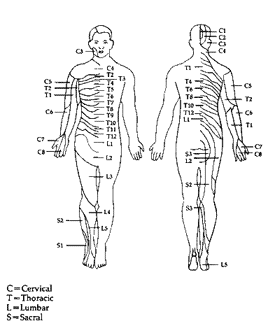 |
Distribution of Segmental Nerves e.g., If the roots of 1st sacral nerve are compressed pain is felt on outside of foot (the areas indicated are from the spinal level indicated by letter and number). |
Professor Korr stands out as the leading scientific researcher into the osteopathic concept. He coined the phrase 'Somatic component of disease' as far back as 1948, to conceptualize the physical entity which had previously been called the osteopathic lesion. The manner in which the musculo-skeletal system can become involved in disease processes is varied. As we shall discover, the major area through which the musculo-skeletal system influences the body, in health and disease, is through the nervous system. The body of the patient responds, through the nervous system to stimuli from its countless internal sources, as well as from external sources. The responses are mediated through the nervous system. From the neurological viewpoint, osteopathic manipulative therapy is attempting to restore function to areas of the musculo-skeletal system that are responding to increased, or abnormal, stimulation and which are modifying nerve impulses from and to the various body structures and organs. There is no part of the body that is not inter-related with every other part, via the nervous system.
A little known recent development in neurological research has shown that nerves not only carry messages but actually have a trophic function. This means that substances are transported along nerve fibres, in both directions, at varying speeds. Most of these substances are proteins and some are fats. Many degenerative diseases would appear to result from abnormalities in the transportation of these apparently vital substances along nerve pathways. We have for too long thought of the nervous system as simply a network along which impulses and messages are conducted. The implications of the nerve tissues acting as a transportation medium for essential cell substances are far reaching.
Correct Breathing
In a more direct manner dysfunction of the musculo-skeletal system can interfere with respiratory and circulatory function. Few people realize the importance of correct breathing. Not only is this function responsible for providing the body with oxygen but it is also an important means of eliminating waste products. The effect of respiration on the circulation of blood and lymph (through the glands) is profound. As the lungs expand and contract, the diaphram rises and falls, thus altering the relative pressure between the thoracic and pelvic areas. This pump-like action is essential if venous blood is to return efficiently to the heart for re-oxygenation. The heart pumps blood to the legs, but in order to return, the muscles of the lower extremeties need to be in use to produce the so-called 'musclepump' action, whereby as muscles contract they effectively squeeze the blood along the veins (which have no-return valves), and thus enable it to reach the pelvis where the diaphragmatic pump operates. If there is dysfunction in the spine which affects normal breathing, then the efficiency of blood and lymph circulation will be impaired. It is possible to appreciate, therefore, how such conditions as varicose veins and haemorrhoids can be improved by correction of body mechanics.
Unless structure is normal it cannot function normally and the consequences can be far-reaching. Goldthwait[2] states in a criticism of the medical profession, of which he was a respected member:
Not only is little attention paid to differences in structure, but practically no consideration is given to what happens to the function of various organs, when the easily demonstrable malposition of them is considered. Is it not possible that much of what concerns chronic medicine has to do with the imperfect functioning of sagged or misplaced organs? Is it not possible that such sagging results in imperfect secretions, which at first are purely functional but if long continued may produce actual pathology? It would seem to be a matter of common sense to expect health with the body so poised or balanced that all the organs are in their proper position and the muscles in proper balance!
Korr [3] describes the manner in which the musculo-skeletal system most frequently becomes involved in disharmony:
Man's musculo-skeletal system is an incomplete and imperfect—certainly an unstable—adaptation of a basic quadruped system to biped stance and locomotion. The components of a perfect cantilever bridge have been somewhat rearranged and modified by evolutionary process to form a less adequate skyscraper. There is no doubt that gravity is far more demanding of man's resources than of other mammalian species. As a result, local postural stresses, asymmetries, myofascial (soft tissue) tensions and irritations, and articular and peri-articular (joint) disturbances have a particularly high incidence in man. Their probability, always high, increases with time. In man, therefore, gravity has become an environmental factor of great importance.
Korr recognizes that dysfunction may result from injury, but he believes that the main cause is the result of the body's adaptation to erect posture. Individual habits, inherited factors, attitudes, occupations, the development of inborn asymmetries and defects will all add to the picture, as will such factors as obesity and pregnancy. He also points out that such symptoms and signs as pain, tenderness and muscular rigidity in spinal areas, may often result from other tissues or organs which are themselves diseased or under stress, affecting spinal tissue via the nervous system. He states: 'Through the reciprocity of influences between visceral and somatic tissues (organs and body) via the central nervous system, visceral (organ) pathology produces disturbances in musculo-skeletal structures. This is recognized in the concept of the secondary, reflex osteopathic lesion and in the 'splinting' (muscular rigidity) associated with painful visceral (internal organ) syndromes.'